Drift's Guillaume Cabane Drives Conversions from Conversations
Patrick Campbell Feb 21 2018
Great conversations are something that marketers traditionally suck at. The entire field has been geared towards low-cost, low-touch, high-throughput methods for years. ABM has been a push in the right direction, but nowhere near what is needed.
But to generate great conversions, you need great conversations
That was the message from Guillaume Cabane, VP of Growth at Drift, during SaaSFest 2017. During his talk he gave us a little glimpse into what is possible with the right data and the willingness to try new strategies.
In the past 15 years in SaaS, at companies such as Mention, Segment, and now at Drift, “G” has made it his mission to find ways to improve funnels and create “an automated process that does at scale what a human was doing.”
To get an understanding of some of the novel ways Guillaume is using data in his funnels, you should watch the video. If you are short on time, here is a quick breakdown of what “G” sees as the problem and how he is rectifying it.
Marketers: See salespeople as your gold standard
“Within any sales organization, there's always one or two or three really good sales reps. It's consistent. Why is that? What did they do differently? When I listen to the pitches I see what they do that's different. They ask specific questions. They gather data. They don't talk, they don't pitch first. They try to understand the customer, and once they gather that data they personalize their pitch, how they present the product, maybe even the price. That's the gold standard of what we try to replicate in marketing. It's those very good humans.”
Very good salespeople capture data and then use that data, immediately, in the sales process. This is what marketers need to do.
Salespeople are at an obvious advantage, however. They are in the room/on a call with the prospects. They know who they are. They can ask the questions that get the data they need to personalize a pitch. Marketers don't know who it is they are talking to. This is why they do exactly what “very good humans” don't do — they pitch first, they don't understand the customer, they don't personalize the pitch.
This lack of available data has led to marketing going the other way, a problem exacerbated by the explosion of marketing automation tools. These help marketers reach a wide audience, but almost always with the same message. They have lowered customer acquisition costs (CAC) but at the cost of lower conversions.
Times are changing. As David Cancel, CEO at Drift, puts it,
“Most marketing tools and strategies we rely on today are suited for a world that no longer exists.”
The world that exists now is one of 1:1 communication and personalized experience. Customers want to know the people behind the brands and find out information for themselves, aided but not led by the company. There has been one area of marketing where personalization, conversations, and experience have become crucial — account-based marketing.
At this high end, data availability is high and so is value. Companies can afford to spend money wooing these customers at the enterprise-level with highly personalized collateral and 1:1 conversations because of the eventual payoff.
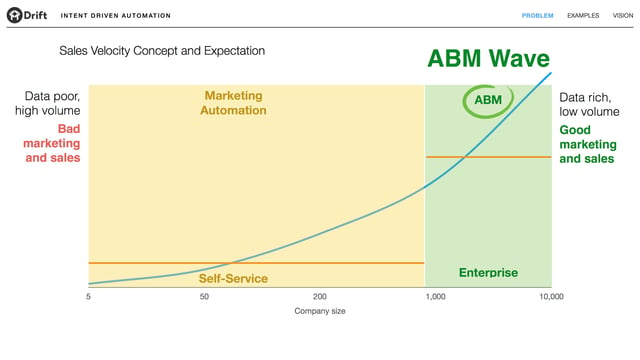
Ideally, marketers would scale the concepts in ABM to the rest of their target market. But, as Guillaume says, “it's really hard to scale unless you can predict who you should target.”
This has become the focus of Guillaume's work. Can you predict who to target and therefore scale the personalization that is so effective in ABM? With the right data, yes you can.
Creating relevant conversations
Creating the conversations that salespeople build naturally is the next step for marketing. But marketers are at a disadvantage. As Guillaume says,
"The problem most of the times is that we don't know before we start the selling process who we are selling to, how much we're gonna be able to charge them for that, if they're going to convert, and how long it's going to take."
There is data available to answer each of these questions. Marketers love data. We capture it all the time. We grab names, companies, email addresses, IP addresses, roles, industries — and so on. Each of these can be used to personalize the experience for the prospect through the funnel.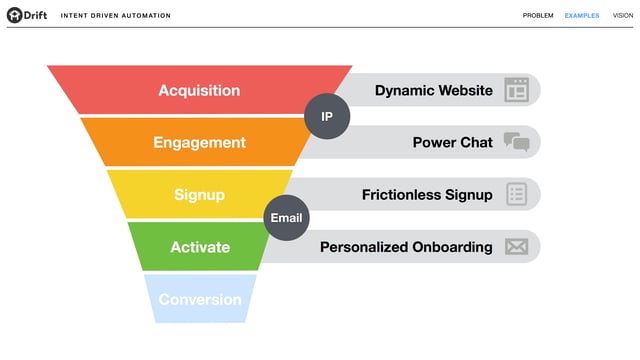 Guillaume builds his personalization in funnels using two main data points: email address and IP address. Let's start at the bottom with email address and work up.
Guillaume builds his personalization in funnels using two main data points: email address and IP address. Let's start at the bottom with email address and work up.
At activation, personalize onboarding
When your product is freemium, then your product is still part of your marketing funnel. Freemium is for acquisition, not revenue. So you have to think about how your onboarding into this product and experience of it will impact the eventual conversion.
Most companies will send a single onboarding email or sequence to all customers containing all information, whether it is relevant or not.
At Segment, Guillaume had seven different emails, depending on the role of the new user. Instead of asking for this during signup and increasing friction, he pulled the role from the user's email address using Clearbit Enrichment. If the new user was a marketer, they would get an email highlighting marketing integrations and how to get Segment started from the dashboard. If they were an engineer, they would get information about how to set up Segment in their app using the code.
Importantly, the marketer's email would be sent in Guillaume's name, the engineering one from an engineer. This personalization meant that new users could reply and start conversations with the right people to help them quickly activate on the platform.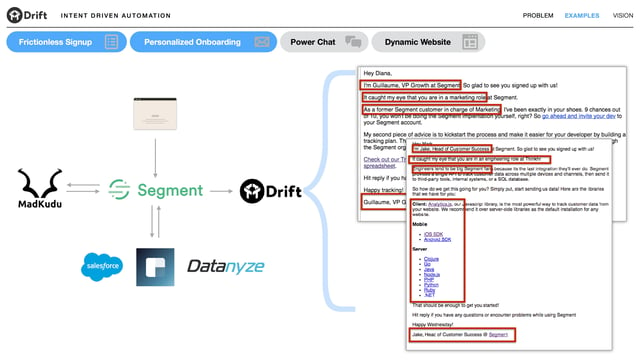
Clearbit has done this using Customer.io to send personalized emails to marketers, salespeople, or developers depending on who has signed up. They saw increased conversion rates across all email types once they started to personalize the message.
At signup, personalize forms
“G” also put Clearbit to use further up the funnel, at the signup phase. Increasing form fields to get data to personalize messaging increases friction and reduces conversions. Email-based data enrichment can be used to decrease friction and increase conversions.
With Segment's “frictionless signup,” the new user would enter their email as on a regular signup form. However, as soon as they tabbed away to the next form field, a piece of JavaScript would send the email address to Clearbit. Clearbit would send data back and prefill the signup form in the browser. From just the email address, the form would fill in name, company, and other fields.
This frictionless signup increased signups by 30%.
At engagement, personalize chat
Understanding users and personalizing your content for them is great for activation. But you are still missing out on activating a lot of people. As Guillaume puts it,
“The problem with that is it only works at the sign up and I only have like 5% signup rate. So there's 95% of my visitors for whom I'm still giving them a crappy experience.”
To increase conversion, and give a better experience, you want to widen the higher levels of the funnel at the engagement and acquisition moments of the conversation.
During his time at Drift, Guillaume has unsurprisingly concentrated on how to do this when prospects visit a site and the company has the chance to chat in real-time with the visitor while they are showing intent. Traditionally, the problem with proactive chat is exactly the problem facing all marketing automation — you don't know who you are talking to so you can target the right visitors.
Using Clearbit Reveal, Guillaume matches the IP address of the visitor to a specific company. This means that visitors are no longer totally anonymous — he can at least put a company to the visit. He can then target high-value companies directly during their visit. Again, he can use data enrichment to find relevant information to start the conversation.
Sales reps start a conversation with a personalized message (“Hey Matt, our scoring model shows Retiremap would be a good fit for our business plan.”), then follow it up with social proof based on the industry of the visitor (“We've helped companies like Instacart, Crate and Barrel, and IBM to integrate tools like Mixpanel, GA, and GTM.”) and finish with a CTA (“Want to schedule a demo of Segment?”)
Guillaume said that there was a 5X increase in conversion rates and, because they were able to target, 80% of conversations were with high-value customers. It also decreased the time-to-demo as reps were able to take action there and then. This is the ultimate version of “the power of right the f**k now” that Steli was also talking about. The proof of the positive effect is how the salespeople saw manning the chat,
“Now the reps are battling to man the chat because they know they can close the quota!”
At acquisition, personalize sites
Even before you start the conversation, the personalization can start. Using the same knowledge, the conversation starters from chat can be injected into the page.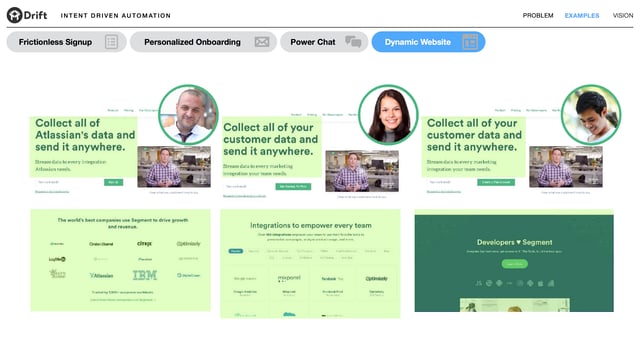
In the above example, the first page is shown only to visitors from Atlassian, the second to a marketing company, the third to developers. Anything on the page can be changed dynamically depending on the visitor. As Guillaume puts it,
“If we have Nike coming to our site, do I want Nike to see my self service pricing that starts like $99 a month? Hell, no! My competitors in the enterprise market don't even have pricing on the page, they only have 'contact us.' Because Nike, when they see the sign up for the free trial $99 kind of thing they think, 'that's not for us. We're out.' By doing this it's actually creating an experience which is relevant to the expectations of Nike and at the same time creating an experience relevant for the expectations of a mid-market company and a small company. It's optimizing for all.”
The hero message, the CTA, the pricing, integrations, logos — anything that might affect the buying decision can be switched out to create that relevant experience for each different customer.
Learning more
In his talk, Guillaume goes into further detail on each of these subjects and more. He shows how he is using sales velocity to understand his marketing funnel, how to find intent even before people visit your site, and how he is also using data behind the scenes to better decide who he should start conversations with.
By building statistical models using this data, he has found:
-
-
- One-seventh of customers generate 80% of new revenue, and he can know which customers will convert and expand at signup.
- The difference between a lead scored “good” by his models and “very good” is a 9X increase in sales velocity.
- He can build emails that have 80% open rates and 20% conversion rates, simply because they are super-targeted to the intent of the prospect.
-
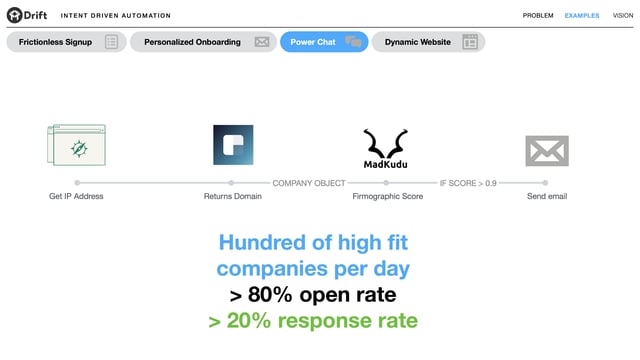
Watch the video to learn more and find out how you can start personalizing every touch you have with your prospects, no matter where they are in the funnel.
By Patrick Campbell
Founder & CEO of ProfitWell, the software for helping subscription companies with their monetization and retention strategies, as well as providing free turnkey subscription financial metrics for over 20,000 companies. Prior to ProfitWell Patrick led Strategic Initiatives for Boston-based Gemvara and was an Economist at Google and the US Intelligence community.

